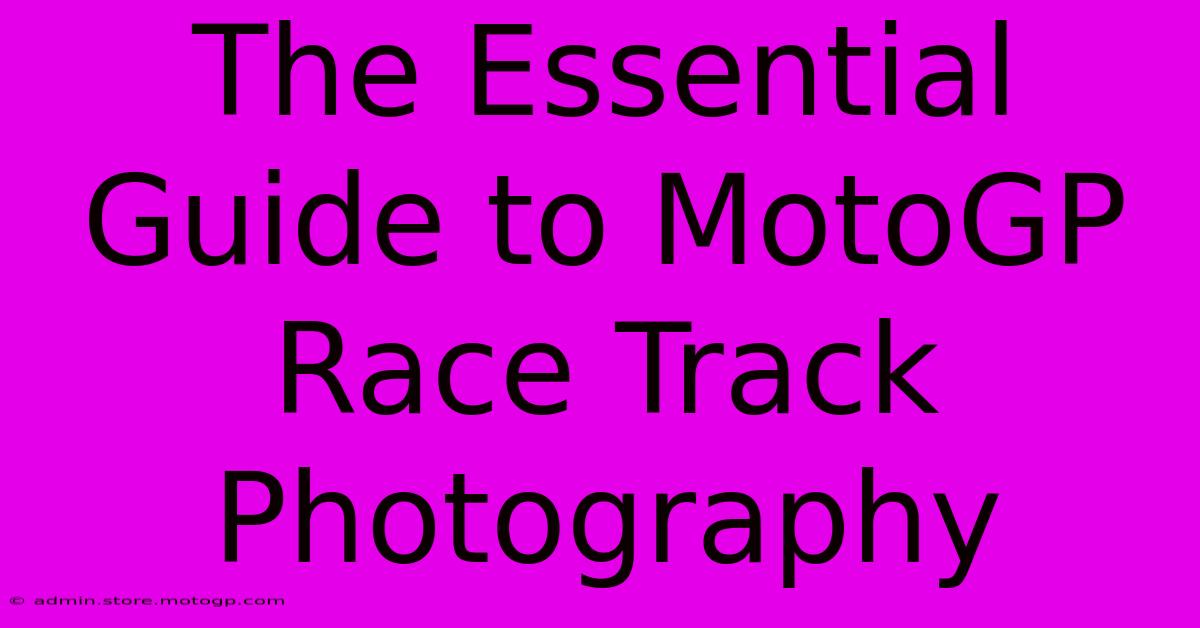The Essential Guide To MotoGP Race Track Photography

Table of Contents
The Essential Guide to MotoGP Race Track Photography
MotoGP. The sound, the speed, the sheer spectacle. Capturing the heart-stopping action of a MotoGP race on camera is a dream for many photographers. But getting those stunning shots requires more than just pointing and shooting. This guide will equip you with the essential knowledge and techniques to elevate your MotoGP race track photography from amateur snapshots to professional-quality images.
Gear Up for the Grand Prix: Essential Equipment
Before you even think about framing that perfect shot, you need the right tools. Investing in quality equipment is crucial for capturing the speed and dynamism of MotoGP.
1. The Camera: Choosing Your Weapon
You'll need a camera capable of handling fast shutter speeds and continuous shooting. A DSLR or mirrorless camera with a fast autofocus system is essential. Consider cameras with features like:
- High frame rate: A burst mode capable of at least 10 frames per second (fps) is ideal for catching those fleeting moments.
- Fast autofocus: Predictive autofocus is a must to keep the bikes in sharp focus even as they speed across the track.
- Robust build: MotoGP tracks can be dusty and sometimes wet, so a durable camera body is important.
2. The Lens: Zoom into the Action
The ideal lens for MotoGP photography is a telephoto lens with a long reach. A lens in the 70-200mm range (or even longer) is recommended to capture close-up details of the bikes and riders. Consider a lens with a fast aperture (f/2.8 or faster) for better low-light performance and shallow depth of field.
3. Accessories: Enhancing Your Shots
- Fast memory cards: High-capacity and high-speed memory cards are vital for continuous shooting without buffering delays.
- Extra batteries: Shooting all day requires plenty of power. Spare batteries are a must.
- Remote shutter release: Minimizes camera shake, especially when using a long telephoto lens.
- Monopod or tripod: A monopod offers stability for handheld shooting while a tripod (though less practical) can be beneficial for specific situations.
Mastering the Art of MotoGP Photography: Techniques and Tips
Now that you have the gear, let's talk technique. Mastering these skills will transform your images from good to great.
1. Shutter Speed: Freezing the Action
High shutter speeds are paramount in MotoGP photography. You need to freeze the motion of the bikes and riders, capturing sharp details without blur. Experiment with shutter speeds starting at 1/1000th of a second or faster, adjusting as needed based on lighting and the bike's speed.
2. Aperture: Controlling Depth of Field
While a fast shutter speed freezes motion, your aperture controls depth of field. A smaller aperture (larger f-number) provides a greater depth of field, keeping both the foreground and background in focus. A wider aperture (smaller f-number) creates a shallower depth of field, blurring the background and drawing attention to the subject. Experiment to find the right balance.
3. ISO: Balancing Light and Noise
ISO controls your camera's sensitivity to light. Lower ISO settings result in less noise but require more light. Higher ISO settings are needed in low light conditions but can introduce noise into your images. Aim for the lowest ISO possible while maintaining a fast enough shutter speed.
4. Composition: Framing the Perfect Shot
Consider these compositional elements for impactful images:
- Leading lines: Use the track itself as a leading line to guide the viewer's eye to the bikes.
- Rule of thirds: Place the bikes off-center to create a more dynamic composition.
- Negative space: Use empty space around the bike to emphasize its speed and movement.
- Action and anticipation: Capture the bikes as they approach corners or exit turns for maximum drama.
Beyond the Track: Post-Processing and Sharing Your Masterpieces
Your work doesn't end when you press the shutter. Post-processing enhances your images, bringing out their full potential. Use software like Adobe Lightroom or Photoshop to:
- Adjust exposure and contrast: Fine-tune the brightness and darkness of your images.
- Sharpen details: Enhance the sharpness of the bikes and riders.
- Reduce noise: Minimize any graininess caused by high ISO settings.
- Crop and straighten: Improve composition and eliminate distracting elements.
Finally, share your stunning MotoGP photography! Use social media platforms like Instagram, Flickr, and 500px to showcase your work and connect with other motorsport enthusiasts. Consider adding relevant hashtags like #MotoGP, #MotorcycleRacing, #MotorcyclePhotography, and #RacePhotography to increase your reach.
By following this essential guide, you can capture the thrill and excitement of MotoGP racing, creating images that perfectly encapsulate the speed, power, and artistry of this incredible sport. Remember practice makes perfect – so get out there, shoot, and enjoy the ride!

Thank you for visiting our website wich cover about The Essential Guide To MotoGP Race Track Photography. We hope the information provided has been useful to you. Feel free to contact us if you have any questions or need further assistance. See you next time and dont miss to bookmark.
Featured Posts
-
Legends Of The Track The Best Motorcyclists Ever
Feb 19, 2025
-
Austin Gp Sprint Race The Best Of Both Worlds
Feb 19, 2025
-
Motorcycle Grand Prix Winners Secrets To Their Success
Feb 19, 2025
-
Columbus Unlock The City With Cota One Day Pass
Feb 19, 2025
-
Austin F1 Map Plan Your Cota Adventure Today
Feb 19, 2025
